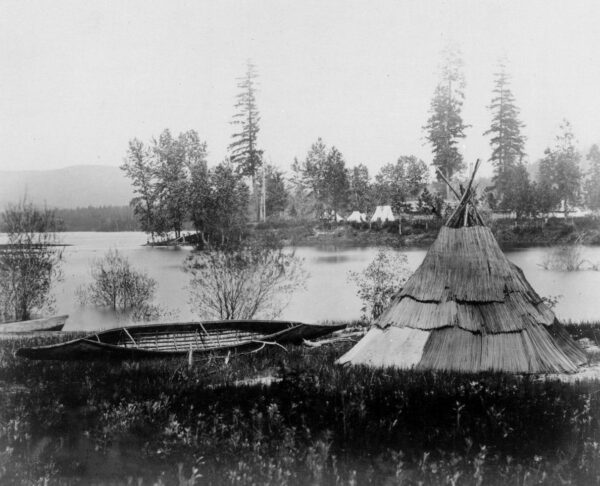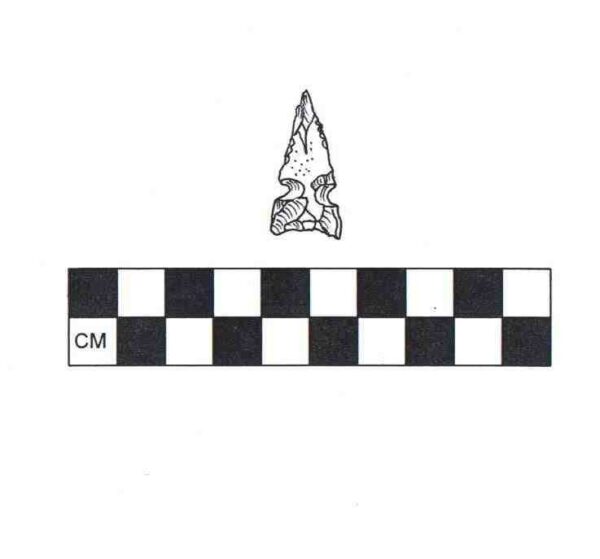Be Bear Aware This Spring
This spring we are experiencing increased bear activity on and near the Reservation. When you are out in the woods it is a good idea to carry bear spray. To…
Read Article
The traditional homeland of the Kalispel surrounding the Pend Oreille River was vast and abundant. It included the mountains, rivers, lakes and prairies that stretch like several entwined strands of green, blue and silver beads from the Pend Oreille Lake to where Paradise, Montana now stands and Northwest ward across Northeastern Washington to the mouth of the Salmo River, just over the international border with British Columbia. It was the Pend Oreille and Clark Fork Rivers which bound together one end of Kalispel country to the other, some 200 miles in length.
 Seneacquateen Mat Lodge & Canoe
Seneacquateen Mat Lodge & Canoe
During the mid to late 19th century, the Kalispel Tribe of Indians worked to preserve our culture and way of life in the midst of increasing white settlement in the area. Roman Catholic priests began working with the Tribe in 1844. In 1855, the Upper Kalispel Tribe ceded its lands and moved to the Jocko Reservation in Montana at the request of the U.S. Government. The Lower Kalispel Tribe, ancestors of today’s Kalispel members, refused to give up ancestral lands and continued to work toward an agreement that would allow the Tribe to remain on its homeland.
During the late 1800s, while most other tribes were going through the process of having reservations established, the Kalispel Tribe of Indians had almost no relationship with the federal government. Congress did propose a treaty in 1872 that would have encompassed more than a million acres of land, but the terms were poor and the Tribe refused to sign it. By 1874, Congress had stopped establishing treaties with tribes altogether, leaving the Kalispel Tribe with no legal protection.
By 1875, the Tribal population had shrunk to only 395 people. From 1880 to 1910, as more white settlers moved into Kalispel territory, the Tribe witnessed its land disappearing but could do nothing to prevent it. Many of the white settlers filed claims under the Homestead Act in order to “legally” obtain land which was rightfully home for much of the Tribe. This time period also introduced the widespread use of alcohol, which many consider to be a fundamental source of the breakdown of the family unit.
For generations, Kalispel members remained trapped in a subsistence environment. In 1965, only a couple of homes on the reservation had running water and there was only one telephone for the Tribe. The average annual income for a Tribal member was approximately $1,400.
The Kalispel Tribe of Indians has faced several challenges associated with life in remote rural areas, such as unemployment, inadequate housing, limited economic opportunities, and prejudice. With most of the land on the Reservation unsuitable for development, the Tribe has had to develop innovative ways to create opportunity for Tribal members. The Tribe’s pioneering spirit, combined with sheer determination, resiliency and community cohesiveness, has allowed the Tribe to overcome many difficult circumstances.
This one-day, hands-on event offers local youth the opportunity to explore forestry and natural resources professions, and is coordinated by the Kalispel Natural Resources Department and the Pend Oreille Conservation District.

The Wildlife Program also has an active realty function. We are focused on purchasing land from willing sellers in order to expand access and harvest opportunities for Kalispel people. To date, the KNRD has acquired over 5,000 acres of land with various sources of funding, including federal hydropower wildlife mitigation lands as the largest contributor.
Using the best available scientific information and technology and working with our conservation partners we endeavor to create a landscape that is resilient to an ever changing climate. To do this requires a balanced and pragmatic approach. We will never return our lands to what they once were but we will always strive to create a future for our children that is better than what we have today.

Cultural Resources, unlike many of our natural resources are not renewable. If they are destroyed they are lost forever. The Cultural Resource Program is tasked with conserving the Tribe’s historic places and maintaining access to culturally utilized places. The major threats to our cultural resources are future land conversion and resource extraction, climate change and invasive species.
The Geospatial Information Systems (GIS) program was created as part of a fisheries contract between the Kalispel Tribe of Indians and the Bonneville Power Administration. It assists KNRD personnel in geographic analysis, map production and data collection where geospatial technologies are needed. In addition, the program maintains a large inventory of geospatial data.
GEDMS (Geospatially Enabled Database Management System) is an interactive online natural resource-focused dta warehouse. GEDMS contains regional metrics targeting water resources, fish populations and related habitat, forest conditions and monitoring wildlife species information.